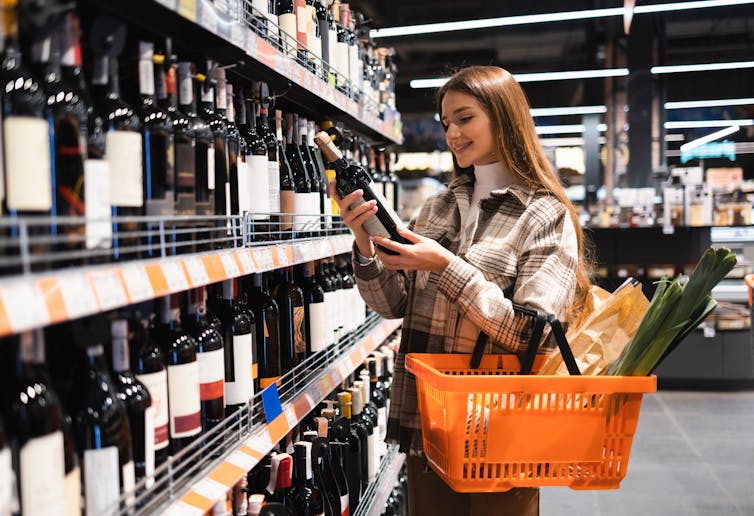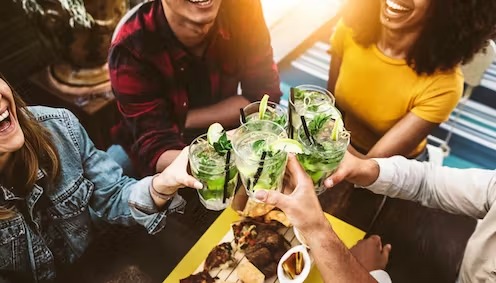Dry July, an Australian fundraising campaign to support people affected by cancer, is almost here again. The premise is that abstaining from booze and hangovers for a month frees up money to donate.
But with prices in the booming alcohol-free drinks category often rivalling those of regular tipples, participants this year might find they have less spare cash than they anticipate.
Traditional alcohol producers, who have expanded into the US$11 billion non-alcoholic drinks industry, have helped make the high prices charged seem acceptable to consumers by using a marketing tactic called price-anchoring.
Lured into paying more
When we encounter a new product, we latch onto whatever seems relevant in the immediate environment to estimate its value. Sellers often exploit this by staging information at purchase points. The classic is a price tag with $99 struck out and $79 written in. Whether it’s accurate or not, the $99 reference point shapes our perception of value and price.
This so-called “price anchoring”, is just one example of the broader anchoring cognitive bias described by psychologists Amos Tversky and Daniel Kahneman.
The essence of anchoring is that we tend to rely too heavily on an initial piece of information (the “anchor”) when making decisions. This can lead to skewed judgements and poor decisions in everything from deciding whether to have surgery to buying real estate.
Anchoring has been used to reinvent and elevate the virgin drinks category by exploiting the fact we are used to paying high prices for alcohol in bottles, cans or glasses of a certain size, shape and sophistication. When alcohol-free versions with similar labels appear beside them on the shelf, website or menu, we tacitly accept they should command roughly the same prices.
It’s not just that the next bottle along provides a suggestive price. Our brains, steeped in marketing, know that alcohol prices can range far upwards from “normal”, making them not just comparison points but the proverbial $99 scratched out. So even if we spend a lot on non-alcoholic wine, we feel like we have scored compared with what we might have dropped on a bottle of Grange.
Where we are most susceptible
The effect is strongest in bottle shops and bars, where the glitz of alcohol marketing, social pressure and the sheer number of expensive items overwhelms our rational thinking. But it also works on websites of the national liquor outlets where special zero-alcohol categories have been established beside the traditional beer, wine and spirits listings.
It doesn’t take much browsing to confirm that prices are similar. Currently, on one of the big retailers’ websites, a case of 330ml bottles of Heineken Lager (5% alcohol) is $55, Heineken 3 (3.3% alcohol) is $50, and Heineken Zero (less than 0.5% alcohol) is $49. Among the non-alcoholic spirits, 700ml of Lyre’s Dry London Spirit - “crafted to capture the essence of a classic gin” - is $51 at another outlet while the same size bottle of 37% alcohol Gordon’s London Dry Gin is $45. Gordon’s own non-alcoholic offering - Gordon’s 0.0 Alcohol Free - is listed at $38.
Price anchoring in the alcohol-free market comes with an extra twist of lemon.
Brands will encourage you to think their investment in developing “healthier options” using “high-quality ingredients” means high prices are fair enough, and that a non-alcoholic drink made with arcane “botanicals” and “adaptogens” in a nice bottle is worth a splurge.

We get caught thinking it’s worth paying extra for non-alcoholic versions of well known brands. www.shutterstock.com
But look at what makes up the price. All processed drinks incur a Goods and Services Tax (GST). And drinks that contain alcohol are hit with a heavy additional excise. The exact percentage is difficult to calculate, but the alcohol-related tax on a bottle of full-strength beer can exceed 30%.
Industry players don’t pay that tax on non-alcoholic drinks. So, in a sense, they are pocketing a hefty bonus that well-anchored customers forget is not being passed on to the government. Ouch.
Supermarkets and nurturing the next generation
Seemingly at odds with price anchoring is the appearance of non-alcoholic versions of some famous brands in supermarkets.
An incentive for names like Heineken, Coopers and Gordon’s to be in supermarkets is visibility in a family-friendly environment. Their brand becomes recognisable to customers who are underage now, but will soon be ready to buy alcohol for their 18th birthday bash.
It’s a risky strategy, however, and can attract adverse publicity. In fact, to protect their reputations, several supermarket chains in New Zealand require customers to show ID when purchasing non-alcoholic lookalike drinks.
Is there a way to overcome the illusion?
The Australian government’s Behavioural Economics Team (BETA) has an informative blog post on minimising the impact of price anchors. But research suggests even experts are susceptible.
Besides awareness, you can reduce the effect by curating your exposure to price information. If you need non-alcoholic drinks for home or an event, visit the supermarket before the bottle shop. The range may not be as big, the drinks may not be any cheaper, and you may need to go to the bottle shop anyway. But the experience will put the untaxed non-alcoholic products in a fairer context – the soft drink aisle. Comparing prices under those sober lights, you might suddenly feel like picking up a bottle of ginger ale instead.
In bars and clubs, you can try to flip the script. Ask for your soda water in a fancy glass with lots of ice and slices of lemon or lime. This anchors what’s in your hand to high-priced cocktails.
Of course, if you embrace the life of a true ascetic, H₂O is a zero-dollar option that, as Nietzsche said always suffices. In Dry July, you might even join the hype and call it non-alcoholic vodka.



 UPS MD-11 Crash Prompts Families to Prepare Wrongful Death Lawsuit
UPS MD-11 Crash Prompts Families to Prepare Wrongful Death Lawsuit  EU Prepares Antitrust Probe Into Meta’s AI Integration on WhatsApp
EU Prepares Antitrust Probe Into Meta’s AI Integration on WhatsApp  Samsung Launches Galaxy Z TriFold to Elevate Its Position in the Foldable Smartphone Market
Samsung Launches Galaxy Z TriFold to Elevate Its Position in the Foldable Smartphone Market  Sam Altman Reportedly Explored Funding for Rocket Venture in Potential Challenge to SpaceX
Sam Altman Reportedly Explored Funding for Rocket Venture in Potential Challenge to SpaceX  Hikvision Challenges FCC Rule Tightening Restrictions on Chinese Telecom Equipment
Hikvision Challenges FCC Rule Tightening Restrictions on Chinese Telecom Equipment  ExxonMobil to Shut Older Singapore Steam Cracker Amid Global Petrochemical Downturn
ExxonMobil to Shut Older Singapore Steam Cracker Amid Global Petrochemical Downturn  Australia Moves Forward With Teen Social Media Ban as Platforms Begin Lockouts
Australia Moves Forward With Teen Social Media Ban as Platforms Begin Lockouts  IKEA Launches First New Zealand Store, Marking Expansion Into Its 64th Global Market
IKEA Launches First New Zealand Store, Marking Expansion Into Its 64th Global Market  U.S. Backs Bayer in Supreme Court Battle Over Roundup Cancer Lawsuits
U.S. Backs Bayer in Supreme Court Battle Over Roundup Cancer Lawsuits  Momenta Quietly Moves Toward Hong Kong IPO Amid Rising China-U.S. Tensions
Momenta Quietly Moves Toward Hong Kong IPO Amid Rising China-U.S. Tensions  USPS Expands Electric Vehicle Fleet as Nationwide Transition Accelerates
USPS Expands Electric Vehicle Fleet as Nationwide Transition Accelerates  Morgan Stanley Boosts Nvidia and Broadcom Targets as AI Demand Surges
Morgan Stanley Boosts Nvidia and Broadcom Targets as AI Demand Surges  Tesla Faces 19% Drop in UK Registrations as Competition Intensifies
Tesla Faces 19% Drop in UK Registrations as Competition Intensifies  Trump Administration to Secure Equity Stake in Pat Gelsinger’s XLight Startup
Trump Administration to Secure Equity Stake in Pat Gelsinger’s XLight Startup  Rio Tinto Raises 2025 Copper Output Outlook as Oyu Tolgoi Expansion Accelerates
Rio Tinto Raises 2025 Copper Output Outlook as Oyu Tolgoi Expansion Accelerates  Michael Dell Pledges $6.25 Billion to Boost Children’s Investment Accounts Under Trump Initiative
Michael Dell Pledges $6.25 Billion to Boost Children’s Investment Accounts Under Trump Initiative  Amazon Debuts “Amazon Now” for 30-Minute Ultrafast Grocery Delivery
Amazon Debuts “Amazon Now” for 30-Minute Ultrafast Grocery Delivery 































